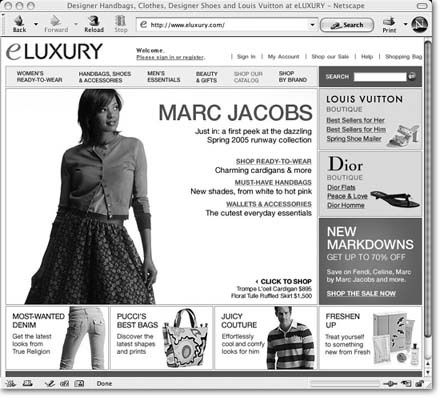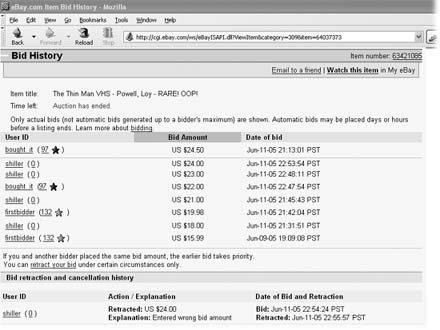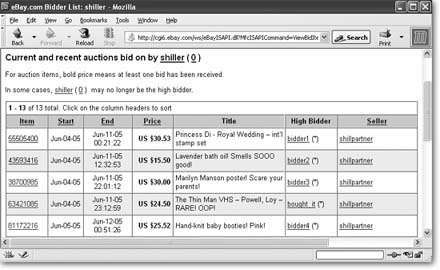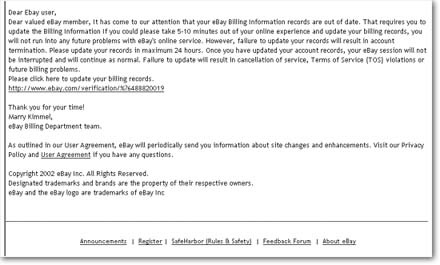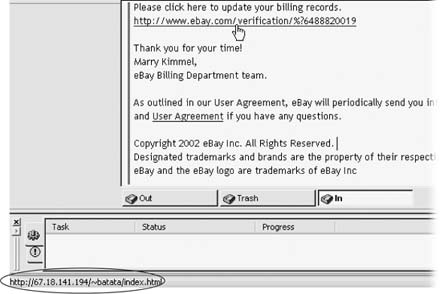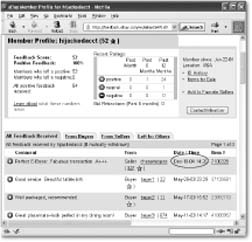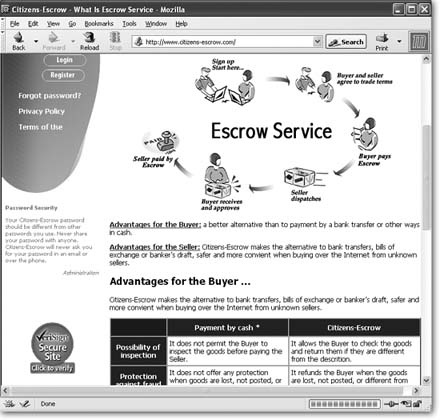Internet fraud is all over the news. And more than 60 percent of online fraud complaints are about online auctions. On the other hand, according to eBay, less than 1 percent of its auctions involve fraud.
Most eBay buyers and sellers are honest; the feedback system soon reveals those who aren't. But the scammers are there. eBay's size makes it easy to hide one fake auction, and the large number of newbies attracted to the site, eager to bid before learning their way around, means a constant supply of new people to con. This section shows you how to avoid becoming one of them.
Note
eBay works hard to shut down scammers on the site. According to Matt Halprin of eBay's Trust & Safety Group, eBay NARU'd over a million accounts in 2004. Not all of those million accounts were scammers, of course; other violations (like moving and forgetting to change your contact info) can result in suspension from the site. And when you consider eBay's gargantuan size, it means more than 99 percent of eBayers do play fair.
eBay finds scammers when other eBayers report them. So if you see anything fishy going on, like one of the scams described in this section, go to Help â Security Center and let eBay know.
After five months of buying and examining products sold through eBay, Tiffany & Co. estimated that nearly three-quarters of all Tiffany items sold on eBay are fakes. Burberry contends that the number of sham Burberry items is closer to 90 percent. Whether you're looking for jewelry, handbags, watches, designer jeans, sunglassesâanything where the brand mattersâbe warned in advance that many of the "deals" you'll find on eBay really are too good to be true.
Cheap knockoffs of exclusive, high-priced designer goods have flooded the market worldwide in recent years. It's become such a problem that eBay has set up a special program for designers to report (and remove) auctions for fake goods; see the box on Section 4.3.2 for more about this program, called VeRO.
When you can examine the merchandise in person, you can check for clumsy stitching, misspelled labels, cheap zippers or other hardware, smudged or uneven lettering in authenticity stamps, and other giveaway signs. With an online auction, though, you can't give the goods that kind of inspection until after you've paid. Other than avoiding designer auctions altogether, what can you do?
You can follow these smart fake-busting strategies:
First, research the product. Go to the designer's Web page or an approved online merchant like eLUXURY (www.eluxury.com; Figure 4-6) and study the details. Then compare the real thing to the auction you're considering. Are the colors the same? Does the online auction photo hide details that should verify authenticity? Is the stitching even, or does it call attention to itself? A handcrafted wallet should not look like a mass-produced item.
Figure 4-6. eLUXURY.com, owned by LVMH (Louis Vuitton, Moet, Hennessey), is an authorized online retailer of many designer brands. It's a good place to inspect the details of high-end retail merchandise, so you can compare those details with pictures of items up for bid on eBay. When you're looking at a particular item, use eLUXURY's alternate views and zoom feature to scrutinize the real thing.
Pass on any auction that fails to include a photo of the item. If the seller included a photo and it looks good, double-check to make sure it's not merely a copy snagged from the manufacturer's Web site. You want to be as sure as you can that the photo on the auction page is the actual item up for bid. In fact, one photo doesn't tell you all that much. Click the "Ask seller a question" link to request more pictures.
Keep an eye out for these telltale clues. Would you sell a $25,000 Rolex for $19.99? A ridiculously low starting price with no reserve is a clue that the seller doesn't have much to lose, because the item isn't genuine. For another clue, click the "View seller's other items" link. Does the seller have dozens and dozens of listings for brand-new, high-end merchandise? Companies like Louis Vuitton, Chanel, and so on do not wholesale to independent eBay sellers. So where's the seller getting all this stuff?
Tip
To boost your chances of finding an authentic designer item (say, a Gucci handbag), look for a gently used bag offered by someone who's not selling a boatload of Gucci stuff. And odds are that someone selling a real, live, second-hand Gucci bag has started the bidding at a price high enough to recoup some of its original purchase price.
Check the seller's member profile and feedback. If other buyers of similar items complain they've received fakes, it clues you in to what that seller is really offering. A relatively new seller who has tons of cheaply priced luxury goods probably isn't selling the real thing. Even a seller with 100 percent positive feedback can be suspect; did most of it come from members who are no longer registered? Was the positive feedback from buying or selling? What kinds of items? You might want to think twice before bidding on a Louis Vuitton clutch offered by someone whose entire trading history so far consists of buying and selling one-cent recipes.
Trust your gut. Use some common sense. If someone is selling a Coach bag, claiming to have original tags and a receipt from Bergdorf's, why didn't the person just return the bag to Bergdorf's for a store credit? Why would the seller put it on eBay and lose so much original purchase price? The old "I waited too long to take it back" excuse is baloney. If you had $1,200 on the line, you'd make it a priority to return the item and get your money back, wouldn't you?
When it comes to designer auctions, know that there are a lot of fakes out thereâsome would say that most of the designer products up for auction on eBay are fakeâand proceed with caution. If you have any doubts, don't bid.
Shill bidding is the practice of placing false bids to drive up the price of an item artificially. Sometimes a seller will bid on his or her own items from a second account; other times friends or family members will bid on items they have no intention of buying, just to get the seller a better price. Shill bidders often try to start a bidding war, getting other bidders caught up emotionally until they've bid beyond their better judgment. When the bidding stops, the shill bidder retracts his high bid, leaving another bidder holding the bag.
Shill bidding is annoying and dishonest; rather than letting the marketplace determine the price, shill bidders push it up. And eBayers get cheated out of bargains.
Besides all that, shill bidding is illegal.
One way to avoid shill bidding is to save your bid until late in the auction. If you snipe the auction, shill bidders won't have time to push up your bid.
But what about an auction that already has some bids? Can you determine whether the bidding is legitimate, showing real demand for the item, or artificially inflated? The first place to look is the item's bid history; on the auction page, click the History link (Figure 4-7). Shill bidders tend to put in really high bids (then retract them) or nibble (Section 3.3.1.2) at an item until they've revealed another bidder's maximum. These strategies aren't proof of shill bidding, but they're a place to start investigating.
Figure 4-7. In this auction, shiller waited until a bid was placed, then made small bids to try to keep others bidding. The first bidder dropped out when the bidding got past $20. When a new bidder got involved, shiller kept nibbling the bids up, then dropped out of the bidding 10 minutes before the auction's end. Shill bidders also have a tendency to retract their bids as late as possible in an auction; look for bid retractions under "Bid retraction and cancellation history" at the bottom of the page.
Looking at the bid history doesn't tell you the whole story, though. Some nibblers put in lots of small bids because they don't understand how proxy bidding (Section 2.2) works and they're trying to get a deal. But those nibblers are legitimate bidders who pay for the items they win.
One way to tell the nibblers from the shill bidders is that shill bidders tend to keep putting in small bids until they've made it to high bidderâthen retract their most recent bid, leaving another bidder on top of the pile. They do this to make sure that the price gets as high as it possibly can.
If you think a Bid History reveals a possible shill bidder, the next step is to hunt down other auctions the suspect's bid on: hit Advanced Search â Items by Bidder. Type the suspected shill bidder's eBay ID in the text box and check "Include completed listings" and "Even if not high bidder." Maximize the number of results displayed per page, and then click Search; the results may be enlightening. Shill bidders tend to bid only on the auctions of one particular seller; another clue is that a bidder has been on eBay for a long time but never won an auction. See Figure 4-8.
Figure 4-8. The shill bidder bids only or predominately on one seller's auctionsâand never wins. In this case, the shill bidder bid a variety of auctions up to a high price and then dropped out of the bidding. All the auctions were from one seller.
Shill bidders often have a lot of retractions in their Member Profile. If the shiller becomes the high bidder, she retracts the bid and drops out of the auction, leaving the next highest bidder the winner.
If you find someone you think is shill bidding, report it to eBay using the Help â Contact Us link. eBay will investigate and, if they agree that the bidder is a shill, will NARU the person. Keep in mind, though, that not all unusual bidding patterns show shill bidding. Newbies are often nibblers. Or a buyer might have a particular seller listed as a favorite, returning frequently to that seller's auctions. And a buyer determined to get a particular item, especially below a certain price, is likely to keep bidding on similar items until he or she wins. If you think someone's been trying to push up bids, let eBay check it out.
You might have received emails purporting to be from eBay before you ever even registered with the site. These spoof emails, fake emails sent by scammers trying to steal personal information, usually report an urgent problem with your account (or sometimes merely request routine maintenance). The emails urge you to verify your account details by clicking a link and typing in your ID, password, and sometimes other informationâlike your Social Security number, credit card number, date of birth, and so on. Many people are so used to sending personal information over the Internet that they click the link and type in the required info without giving it a second thought. Later, they'll find themselves locked out of their own eBay or PayPal account as the scammer uses it for fraud or for running up credit card charges.
eBay has taken action to combat spoof emails by enhancing the My Messages section of My eBay. Any official eBay communications about your account will appear there; go to My eBay â My Messages to check your Inbox. If the email isn't in there, it's a spoof.
Note
The practice of sending spoof emails with the intent of stealing account information is also called phishing.
Spoof emails like the one shown in Figure 4-9 can look highly authentic, using the eBay or PayPal logo and valid links to the real sites. But several telltale clues, including a generic greeting, grammatical mistakes, incorrect terminology, and a request to hand over account informationâall items eBay would never include in a legitimate emailâclue you in that the email is bogus. Check out Figure 4-10 to see an example of another dead giveaway common to spoof emails: a non-eBay link.
Figure 4-9. This email has many clues that reveal it's a spoof. eBay doesn't send out emails addressed to "Dear Ebay user"; it greets you by your eBay ID. The letter contains grammatical mistakes, like the phrase "please update your records in maximum 24 hours." The terminology is also wrong. eBay doesn't "terminate" or "cancel" accounts; it "suspends" them. But the biggest clue is the link you're supposed to click to update your billing records. eBay will never, ever ask you for your account information via a link in an email.
When you receive an email that you suspect is spoofed, forward it to spoof@ebay.com (or spoof@paypal.com if it refers to your PayPal account). eBay will get back to you and let you know for sure whether the email is genuine or a fake. The vast majority are fakes. Don't click that link!
If you ever suspect that you've already given your eBay ID and password to a bogus site, you need to do several things immediately:
Make sure your computer is clean. When you followed the link in the spoof email, your computer might have been infected with a virus or spyware (an unwanted, hidden program that monitors and reports your computer activity to people you haven't authorized). If your computer has picked up a keystroke logger, for exampleâspyware that records everything you type and sends that information to a third partyâthe scammer will know when you change your password and what you change it to. So before you do anything else, fire up your computer's virus-protection software (like Norton AntiVirus or McAfee Virus-Scan) to scan for and remove any viruses. Lavasoft's Ad-Aware (www.lavasoftusa.com) can root out and destroy any spyware hiding on your computer.
Sign in to eBay and change your password. You sign in to eBay by typing www.ebay.com into your Web browser's address box and clicking the Sign In/Out link that appears on the eBay home page. If you can't sign in to your account, contact eBay immediately; go to eBay's home page and click Live Help.
Report the bogus site to eBay. To do so, go to the navigation bar and click Help â Contact Us.
Contact PayPal, your credit card company, and your bank. If you gave any information to the bogus site relating to your PayPal account, credit card, or bank account, contact those companies and let them know what happened.
Figure 4-10. Hovering the cursor over the supposed link to eBay reveals that the link won't take you anywhere near eBay. Look at the bottom of the figure. Those numbers after http://are a surefire clue. Rather than starting with http://pages.ebay.com, like a legitimate eBay link, this link takes you to an unknown Web site. The bogus site might look just like eBay, but the information you type in will let thieves steal your identity.
Contact the credit bureaus and Social Security. If you revealed financial information or your Social Security number, notify the three major credit bureaus and the Social Security Administration to put a fraud alert on your information by calling these fraud lines:
| Equifax: 1-800-525-6285 |
| Experian (TRW): 1-888-EXPERIAN |
| Trans Union: 1-800-680-7289 |
| Social Security Administration: 1-800-269-0271 |
Tip
eBay has teamed up with Equifax to fight identity theft. eBayers can order discounted credit reports from Equifax to see whether anything odd is up with your credit. Moreover, you can subscribe to Credit Watch for eBay, which alerts you by email when there are changes to your credit report, like new credit cards or bank accounts opened in your name. Check it out at http://creditzone.ebay.com.
Behind all the spoof emails going around are scammers looking for accounts to hijack. Account hijacking is a form of identity theft. When scammers harvest someone's eBay ID and password from a response to a spoof email, they steal that person's eBay account. The scammer might sign in and change the account's password and contact information, locking out the rightful owner of the account. Or, to avoid detection (because eBay sends you an email when you change your password), the scammer might simply use the hijacked account to create phony auctions, with a note in the item description that says something like,"The Ask Seller a Question link isn't working. If you have any questions, email me at scammer@hotmail.com." If the rightful owner doesn't check his eBay account for a few weeks, he never knows what's going on.
Because scammers use hijacked accounts to run fake auctions for items they don't have, they look for established accounts with a decent feedback score. Smart eBayers are unlikely to buy big-ticket items from a new seller with little or no feedback, so the scammers want to get their hands on the accounts of legitimate eBayers who've earned a good reputation.
When they do, two bad things happen: trusting buyers lose money, and the scam auctions destroy the reputation of the eBayer whose account got hijacked.
Don't be fooled by a scam auction from a hijacked account. Here are some signs that an auction isn't legit:
The seller offers free shipping on an item that would normally cost hundreds of dollars to ship, such as shipping a car from Europe to the U.S.
The seller promises that the item is being inspected in "the eBay warehouse." (There is no eBay warehouse, and eBay doesn't inspect items sold on its site.)
The seller has a lot of auctions running simultaneously for identical high-end items. Such auctions could be legitimate, but check for other warning signs, like payment by wire transfer.
The seller offers to end the auction early, just for you. Think about it a minute. Why would the seller want to end the auction early when the bidding might go higher?
The seller's feedback shows a sudden change in direction, as shown in Figure 4-11. If someone who's specialized in Beanie Babies since 2001 is suddenly selling speedboats, or if someone who hasn't done a thing on eBay for months or years buys a couple of cheap items and then lists a dozen brand-new laptops, avoid their auctions.
Figure 4-11. Reading feedback carefully can reveal a possible hijacked account. In this case, after nearly a year and a half of inactivity, the seller has one recent feedback: for the purchase of a 99-cent recipe. (Check out recent transactions by clicking any active item-number link.) Before that, the feedback shows, the eBayer sold table linens. If this ID is now listing big-ticket auctions for items like electronics or motor vehicles, you've got reason to be suspicious.
Tip
On the auction page, click "View seller's other items" to check the seller's other auctions. If the item description says, "I have to sell this plasma TV because my wife didn't like the way it took over our living room," how come the same seller has half a dozen other, identical plasma TVs for sale?
An escrow service is a third party that people often use in transactions for expensive items. The service holds the buyer's payment (assuring the seller that payment has been made) until the buyer has received, inspected, and accepted the item. Escrow services, described in detail on Section 2.3.1.2, allow total strangers to conduct big-ticket transactions with confidence.
For scammers, bogus escrow sites are a synonym for "easy money." As a buyer, you send in your money, trusting that you can get it back if the item doesn't arrive or isn't of the quality you expected. But the item never arrives, the escrow company doesn't answer your emails, and there's no other way to contact the company. Your money is gone.
Fake escrow services have mushroomed all over the Internet. Often they look professional at first glance, as in Figure 4-12. How can you tell whether a particular escrow service is the real thing?
Figure 4-12. This site, evaluated as fraudulent by SOS4auctions.com, looks professional at first glance but contains a number of telltale signs of a phony escrow site. The page has spelling mistakes ("descrition," "convient"), grammatical errors ("a better alternative than to payment"), and plain old sloppiness. The Verisign seal looks genuine but is a forgery. You can check by clicking it; a genuine Verisign confirmation page always begins with https://seal.verisign.com.
The short answer is to insist on Escrow.com for all escrow transactions, because it's the only U.S. escrow service approved by eBay. If your trading partner tells you they can't or won't use Escrow.comâno matter how good the excuse may soundâdon't continue with the transaction.
Note
If you're trading outside the United States, eBay recommends a few international escrow services. To find them, go to the navigation bar and click Help â AâZ Index â E â "Escrow for Buyers." Scroll to the bottom of the page to see the list of recommended escrow services.
Some scammers will try to convince you that Square Trade is an escrow service. It's not. Square Trade (www.squaretrade.com) is an independent company that does three things related to eBay: it verifies sellers, it mediates disputes, and it sells warranty plans. Square Trade never takes part in ongoing auctions.
Sometimes the high bidder who wins an auction can't (or won't) complete the transaction. Stuff happens: illness, loss of financing, a stubborn case of cold feet. In these cases, eBay lets the seller send out a Second Chance Offer (SCO) to any of the nonwinning bidders. A Second Chance Offer means that even though you didn't win the auction, you can (if you want) buy the item. Sellers can also send Second Chance Offers if they have two or more identical items for sale or if more than one bidder participated in a reserve auction (Section 1.4.2) that failed to meet the reserve price.
If you receive a Second Chance Offer, it will be for the amount of your highest bid, even though that bid didn't win the auction. The item will have a new number, and you can sign in to eBay and use Buy It Now to purchase the item for the amount you bid. There's no obligation to accept a Second Chance Offer, but these offers can be a great way to win an auction you thought you'd lost.
The trouble is that scammers manipulate Second Chance Offers to sell items they don't have. In this type of scam, the scammer looks over the bid history and contacts the nonwinning bidders, offering to sell the item at the bid price. But the scammer isn't the original seller and has no intention of selling anything, just grabbing your money.
How can you tell the difference between a legitimate Second Chance Offer and a scam? Here's a checklist:
Real Second Chance Offers come from eBay and have a link to a Buy It Now page. Also, legitimate Second Chance Offers never have "Question from eBay Member" as their subject lines. Bogus ones come from the scammer's email account or ask you to contact the scammer via email to complete the transaction.
Real Second Chance items have a reassigned item number. To check out an item number, log in to eBay (by typing www.ebay.com into your browser's address box), click Advanced Search, and search for the item number that was in the SCO email. If it brings up the item as a BIN auction with your price as the BIN price, it's legitimate. If it doesn't, it's a scam.
Real Second Chance Offers appear on your My eBay page. You can check whether a Second Chance Offer is legitimate by heading to the navigation bar and clicking My eBay, then checking out the My Summary view. If you don't see a Second Chance Offer listed there, the offer you received is bogus.
Real Second Chance Offers show the original seller. Look up the original auction on eBay. Check to make sure that the seller's ID in the original auction matches exactly the ID of the seller in the Second Chance Offer. Scammers often count on the fact that the bidder is unlikely to remember the original seller's ID.
Real Second Chance Offers link to the relisted item. The link in the SCO should go to the relisted item with a BIN price, not to the original auction.
Real Second Chance Offers never involve wire transfers. The payment options should be the same as those listed in the original auction. Scammers rarely accept PayPal and are likely to insist on instant wire transfer (such as Western Union or MoneyGram). The box on Section 4.3.6 explains why you should never pay via instant wire transfer.
Fake Second Chance Offers often include a list of "five easy steps." The first step is that the seller notifies eBay about the transaction. In a real SCO, eBay already knows about the transaction; the seller has to set things up through eBay before you can receive the offer.
Fake Second Chance Offers often try to reassure the would-be buyer that the auction is legitimate. Common scams include claims that Safe Harbor or Square Trade has approved the seller or that the seller has deposited a large amount of money in an "eBay managed purchase protection account." Neither Safe Harbor nor Square Trade "approves" sellers, andâyou guessed itâthere's no such thing as a managed purchase protection account. eBay doesn't hold money for its sellers.
You can help eBay track down the bad guys by reporting any fake SCO you receive. Go to Help â Security Center to file a report.
If Second Chance Offers make you nervous, you can just tell eBay you don't ever want to receive them. On any eBay page, go to the navigation bar and then click My. On your My eBay page, click eBay Preferences, then, next to Notification Preferences, click View/Change. Scroll down the page to "Second chance offer notice," and make sure the checkbox is turned off. After you've clicked Save Changes to save this preference, eBay won't send you Second Chance Offers, so you'll know that any you receive are scams.
Get eBay: The Missing Manual now with the O’Reilly learning platform.
O’Reilly members experience books, live events, courses curated by job role, and more from O’Reilly and nearly 200 top publishers.
